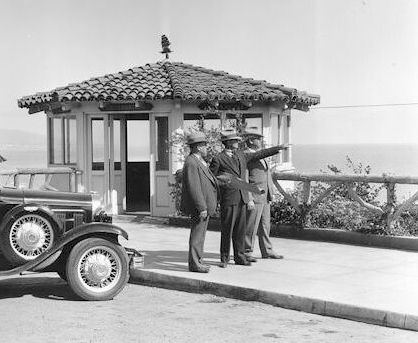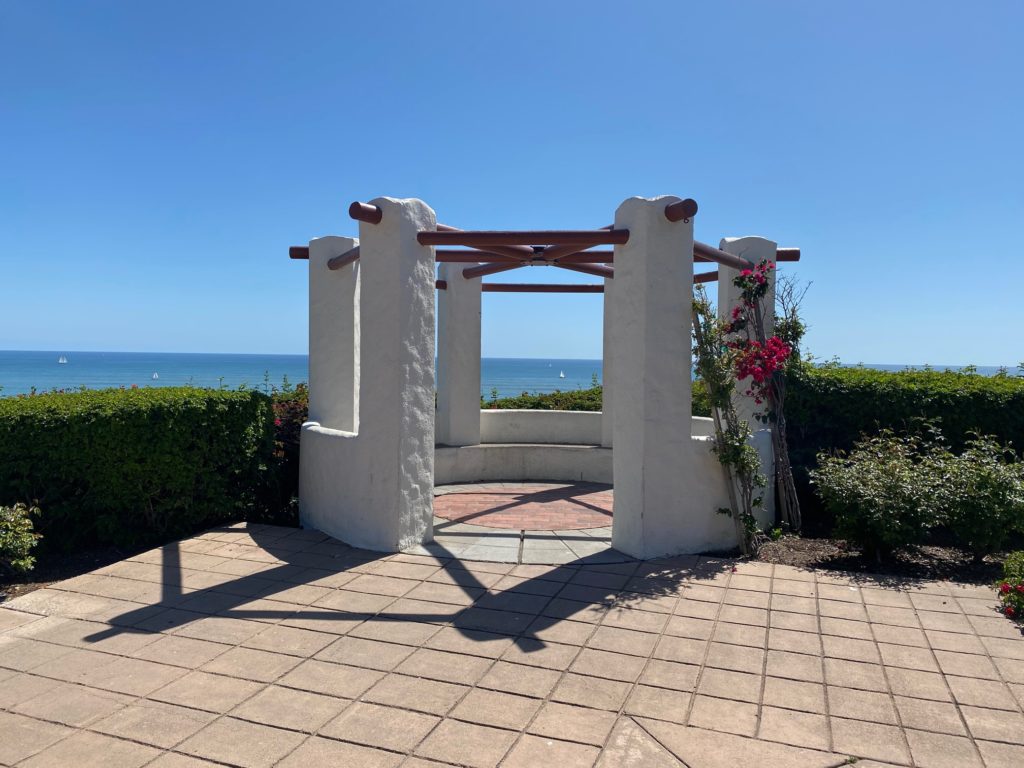by Barbara Force Johannes
The “Blue Lantern Gazebo” (pictured) at the Ken Sampson Overlook Park continues to be fenced off due to a rockslide on January 13, 2018. Cove Road was also closed when 18 tons of rock, including a two-ton boulder, dropped on the stone restrooms below. Cove Road was re-opened but the restrooms below and the gazebo above remain closed and fenced off, although the Ken Sampson Overlook still remains a popular harbor viewing spot.

The South Coast Scenic Improvement Project emphasized the preservation of this historic lookout as a public view point in 1969, as recorded by Doris Walker in Home Port for Romance. “The Blue Lantern Lookout Park” was dedicated in 1975 as an official Orange County Park. The historic red-tiled, octagonal gazebo first appears in our historical photos at about the same time as the Blue Lantern Gas Station Fountain Lunch building, c. 1926-1927. The original site may have been chosen by the San Juan Point Corporation or Anna G. Walters in 1925, but the gazebo was likely built sometime after Sidney H. Woodruff’s investors bought and expanded the Dana Point development in 1926. (Historic photos show Woodruff’s tall-ship logo located at the peak of the gazebo’s tiled roof, pictured) The gazebo’s panoramic location also includes the California State Park Commission’s Historical Landmark No. 189, erected in 1955, which attests to the significance of Richard Henry Dana’s visit in 1835 and, earlier, Hipólito Bouchard’s raid on San Juan Capistrano, flying an Argentine flag, while anchored here in 1818. On September 21, 1978, the quarter-acre site was renamed the Ken Sampson Overlook to honor the Orange County Parks director who had overseen the design and construction of Dana Point Harbor. A commemorative plaque with Ken Sampson’s portrait is placed in the park in tribute to his supervision of local beaches, harbors and parks.

Orange County Parks engaged Page & Turnbull, a preservation architecture and conservancy firm in Los Angeles, to evaluate the Blue Lantern Gazebo with a historic-structure feasibility study. The study describes the Spanish Colonial Revival structure as located at the edge of the bluff on a concrete foundation added in 1989. The ramp that slopes down to the gazebo entrance was added during the 1973 construction of the new plaza. This was a change to the approach, but the gazebo itself was not moved. The gazebo is a wood-frame construction with large corner wood columns supporting wood rafters, wood skip sheathing and a barrel clay tile roof above. The walls are wood frame construction with cement plaster finish on the exterior and wood on the interior. The gazebo was originally fully enclosed with casement window sashes and partially glazed bi-fold entry doors, as evident in our historic photos. After an Orange County Historical Commission meeting in the harbor, I had the opportunity to meet with architect Drew Gorski at the Blue Lantern Gazebo. He pointed to the original recessed areas where window hinges at the existing wood columns showed that the gazebo was once fully enclosed. In the report submitted by Page & Turnbull, the gazebo’s interior cast-in-place floor, featuring a terra cotta compass embedded at the center, was installed with the new foundation in the late 1980s. The terra cotta compass was salvaged from an earlier slab and reinstalled in the current concrete slab. The general condition of the gazebo ranges from poor to good, with the most serious issue identified as the separation of connections between the columns and beams, where beams no longer have full bearing. Interior wood cladding on walls have damage, the walls have evidence of termite damage, and wood sills have both termite and graffiti damage. Areas of concern included erosion of the bluff, which has the potential to undermine the gazebo foundation, as documented in a Limited Geotechnical Review in 2016. The Page & Turnbull report recommended that continuing erosion should be examined by a civil engineer.
The Blue Lantern Gazebo is one of only a handful of remaining historic gazebos built along the Pacific Coast in the 1920s and 1930s. Also still existing is the historic Doheny-era gazebo at the Palisades Gazebo Park in Capistrano Beach (pictured). It is open to the sky, with connecting beams instead of a roof. Built-in benches for gazing at the Pacific Ocean are surrounded by a beautiful rose garden.

The Heisler Park gazebo (pictured) is another. It is now a part of Laguna Beach and its greenbelt named a “Historic American Landscape,” one of only 700 national landmarks in the entire United States to receive such a recognition.

Page & Turnbull has recommended restoring the historic Blue Lantern Gazebo to its original appearance (rendering pictured), including the original faux bois fence of wood-like patterned cement as seen in our historic photos — a style that still remains at the gazebo in Heisler Park.

As of now, there has been no update as to when this restoration might begin.
